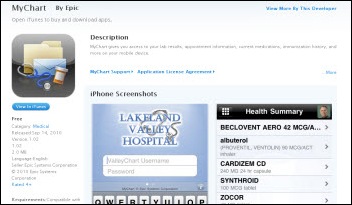"most people just go to Epic" that's a problem because then EPIC becomes a monopoly in healthcare, if it isn't…
News 9/15/10
From Across the Pond: “Re: Alert Online Healthcare, Portugal. Delays all over the place in their first Netherlands implementation of their flagship hospital. It seems they couldn’t deliver the Dutch-specific adjustments in their software on time. Testing was delayed, causing the testing squad of physicians, nurses, and administrative staff to be sent home. Needless to say, the atmosphere is less than sparkling and vibrant right now.” Unverified.
From Nasty Parts: “Re: Sage Healthcare. A new sales approach.” Sage seeks 40 to 50 more solution providers to sell Intergy and Medical Manager, adding to its direct-only channel because it doesn’t have the resources to meet demand.
From Peony: “Re: WellStar. The former cardiology practice of fired CEO Dr. Simone was recently purchased by WellStar for a lot of money. I wonder if this had anything to do with him being fired?” Unverified. I assume that practice is WellStar Cardiovascular Medicine, the 30-doc group he founded. Showing him the door will cost the hospital group $1.8 million, though, since his contract guarantees a paycheck for two years if he’s canned. Ditto for the also-fired general counsel, who will get an $856K parting gift. What the hell are boards thinking when they sign these contracts?
From Cable Cutter, Here: “Re: Verizon. Verizon workers severed a fiber optic cable near Pittsburgh Monday afternoon, affecting businesses and hospitals from Pittsburgh to Steubenville, Ohio and cutting all IT and phone service to thousands. Several call centers were out and emergency calls from hospitals went unanswered.” Unverified. Frontier in Illinois, which took over the old Verizon lines, had the same problem, with hospitals forced to use cell phones for several hours.
From Situation: “Re: MyChart. Now available on iTunes.” Here’s the link.
Related: Dean Clinic (WI) says it became the first hospital to offer Epic on the iPhone Tuesday. The lady in the pink top really chews the scenery with enthusiastic overacting.
From Cmon Man: “Re: FDA regulation of smart phone apps. Patient safety and innovation are intertwined. Usability and efficacy would be escalated by FDA regulation, contrary to the protests of the industry.” FDA is watching app stores for imaging-related smart phone software, saying that anything that sends images to a medical facility requires FDA approval. They also supposedly called out iStethoscope and Instant Heart Rate as apps that might pique their interest. They say they’ll be issuing guidance.
Cmon Man also weighs in on HHS’s spending taxpayer money to design a trademarked phrase and logo for Connecting America for Better Health, saying it’s cutesy, presumptuous, and expensive. He also finds it uncanny that “better health” is part of the name, making it reminiscent of the UK’s Connecting for Health flatlining boondoggle, or the “HIT Devolution” as he calls it. I guess I don’t agree about the cost since the pallets of stimulus cash being shoved out of the HHS plane make this a non-issue, although I agree with the assessment that government-run HIT projects that cost billions are almost always colossal failures. And if you’re going to spend all that money, you might as well give the project an identity.
From Pretty Kitty: “Re: CPHIMS. Tupelo Honey was right. I have come to believe the same and it’s apparent that even HIMSS isn’t investing much effort or support in it. Although I knew I had passed walking out of the testing center, it took two months to receive notification from HIMSS and a year to get notification to my company. Other than a hearty congratulations, the certification has meant nothing. I will not be renewing.” I think HIMSS does OK with CPHIMS, but the bottom line is that generalist certifications aren’t worth much to employers. You can be pretty dense and still pass if you’ve been around awhile and do well on multiple choice tests. But, feel free to weigh in on that survey to your right asking about the value of CPHIMS. It’s still more relevant than CHIME’s Certified Healthcare CIO program, which makes no sense at all (other than the “cents” the related revenue stream brings to CHIME and the anemic ego boost it gives CIOs sporting unimpressive educational backgrounds). If you can show me even one hospital CEO who will state in writing that they hired a CIO because the candidate waved a CHCIO paper in his or her face, I’ll say so publicly (and that would be a terrible reflection on that CEO). In fact, what’s next, a certified CEO?
Listening: new from Stone Sour, the Des Moines band with some Slipknot personnel overlap. And as an intermezzo sorbet, speed punk from Lazy Cowgirls.
Paging Dr. Pronovost: a survey-based study finds that about half of healthcare workers think it’s a good idea for patients to remind their caregivers to wash their hands, yet a third of those respondents say they would not personally appreciate such a reminder. A third also said they would refuse to wear a badge inviting patients to question their handwashing.
The New York Times agrees with my assessment of Hewlett-Packard’s board for firing CEO Mark Hurd on shaky grounds, then suing Oracle for snapping him up. Its conclusion: “The HP board can now lay claim, officially, to the title of Most Inept Board in America … The whole world will know Mr. Hurd walked away with $40 million of HP shareholders’ money, and joined a multibillion-dollar competitor with HP in its sights — and there wasn’t a thing HP could do to stop him. Confidence-inspiring, this ain’t.” It points out that California courts don’t buy the validity of non-compete agreements, which is what HP is suing Hurd over. McKesson CEO John Hammergren, formerly viewed as ept, is one of HP’s board members.
CapSite sent me a copy of their 2010 US Remote Radiology Study. The big players are Nighthawk and Virtual Radiologic, but their share is not very large. It’s still mostly a preliminary reads business, but remote radiology is chosen for other interesting reasons (cost savings, mostly, but also turnaround time). CapSite provides reports and services that help healthcare organizations make informed capital expenditure decisions.
Outpatient imaging center operator RadNet acquires Image Medical Corporation, which owns PACS vendor eRAD of Greenville, SC, for $10.75 million in cash and notes. The publicly traded RadNet, which has $500 million a year in revenue, is forming a software development team for its newly created radiology information technology division. They say they’ll save up to $20 million over ten years by owning their vendor, plus eRAD is bringing in $5 million a year in revenue.
Weird News Andy notes that the last person a surgeon would want to leave a sponge in would be a lawyer. Or a judge, as in this case in Florida, where a surgical sponge and its metal ID tag were repeatedly misidentified over five months as it became infected in the judge’s abdomen, measuring a foot long by a foot wide when doctors finally took it out. Neither the hospital or its owner, Tenet, responded to his questions about how they would prevent the same problem in the future. The judge settled with the hospital, but he’s suing the radiologists and surgeons.
Stuff you can do right here: (a) stick your e-mail address in that Subscribe to Updates box to your right so you’ll be the second to know hot news (after me, of course, since I have to write it); (b) use the Search All HIStalk sites to … well, search all HIStalk sites; (c) Like us on Facebook with that widget to your right or search us out (Tim Histalk and Inga Histalk) and Friend us to support our pathetic illusion of popularity and acceptance; (d) send me a scandalous rumor via the garishly green but soothingly secure Rumor Report box; (e) add your two cents’ worth by leaving a comment or writing a guest article. And indulge me as I profusely thank the companies that sponsor HIStalk, which I think you’ll agree even though you may complain about the number of ads, do perform a service in bravely supporting an anonymous, abrasive, and hard-working blogger who toils by night after sometimes crappy days in the hospital (not usually, fortunately) to bring you news and opinion you wouldn’t hear otherwise (at least until tomorrow when the next rag or blog passes it off as their own creation). Mostly, thank you for reading.
eHealth Ontario signs a $46 million contract with Canada-based CGI Group to develop and manage a diabetes management portal.
Modern Physician names Amazing Charts CEO Jonathan Bertman, MD as its Physician Entrepreneur of the Year. He says he got into the EMR business because of the money, buying Visual Basic for Dummies in 2001 to create a simple, easy-to-use EMR that costs $995 upfront and $500 a year for maintenance (he says, “I like having a car and a house, but I don’t think you need to extort money from colleagues just because you can.”) I’m not sure I’d want him as either a doctor or a vendor given his admission that “In between patients, I would literally run back to my office to write code”, but I assume he’s got people to do that now since the company is up to 30 employees and 3,500 customers and has won some awards. I like his marketing pitch: “Is Amazing Charts crap? Um. No. But don’t take it from us. Try it yourself. As we’ve repeated ad nauseam, you can try it now without any payment or even giving us your name.” In a sideline business, he’ll also sell you a Male Genitalia Guide for $12, which he notes makes a great stocking stuffer (the guide, not the genitalia). Bet you can’t get that from Allscripts or Epic.
Dubai is having an mHealth Conference and Expo this week. Not to be confused with the mHealth Summit in Washington, DC in late October, or the mHealth Ecosystem in Chicago in December, or the mHealth Summit in Washington, DC in early November. The last one is most notable in my opinion because (a) Bill Gates is speaking; (b) the Foundation for NIH is involved; and (c) I’ll be attending and reporting (anonymously and at my own expense and taking time off from work, just in case my mentioning of it is suspect). It’s got a global health emphasis, of which I’m a fan.
The New York State Department of Health funds $109 million worth of HIT grants for 11 organizations, hoping to build an IT infrastructure to support the patient-centered medical home model of care.
A Mayo bioinformatics researcher gets a $3.1 million NIH grant to develop an EMR that will tie drug response to genomic information.
Odd: a hospital in India buys an MRI machine, but shuts it down a month later when it fires the only doctor who knows how to use it. He was on contract from a private lab and was accused of sending patients there instead of doing the work at the hospital. The hospital can’t get radiologists for the “meagre salary” it offers.
Kadlec Regional Medical Center (WA) will deploy Wolter Kluwer Health’s Medi-Span for its Epic EMR.
Also integrating with Epic: Mediware and its HCLL blood transfusion management software.
HIE vendor Availity extends a multi-year contract with Prematics for e-prescribing services and the Prematics Care Communication messaging service.
3M Health Information Systems says its ICD-10 Code Translation Tool is now fully integrated with its medical vocabulary server, the 3M Healthcare Data Dictionary.
Benefis Health System (MT) outsources its HIT functions to Precyse. Sixty Benefis employees, including those in IT, transcription, coding, and medical records, will be offered jobs with Precyse.
Corepoint Health and IPeople partner to offer a bi-directional interfacing solution for Meditech hospitals.
Boston Medical Center will lay off 119 people, including 44 nurses and 30 managers. The hospital is attempting to reverse its projected loss of $175 million for the year. Dartmouth-Hitchcock (NH) will eliminate 300 jobs to stave off its $50 million deficit, but hopes to avoid layoffs.
I see Praxis EMR is applying for HITECH certification through the Drummond Group. I can’t help but wonder if CCHIT is second-guessing its decision to wait until September 20th to announce its final certification and testing plans.
HIT purists: move to the next item while I share healthcare fashion news with our more couture-conscious readers. I do wish HIT involved more fashion-related stories, but this is about as close as it gets. Cleveland Clinic premieres a new Diane von Furstenberg-designed hospital gown that features an elastic waistband (which I don’t think is particularly fashionable, though better than the Johnny gown), wrap-around closure, and a wide V-neck. There’s also a “signature” von Furstenberg element: a bold, graphic print that incorporates the clinic’s logo. Some male patients think it’s too girly-looking, but I bet the Voalte guys would wear it.
AHIMA comments on HHS’s proposed rule-making for HIPAA privacy, security, and enforcement. Key concerns/questions: allowing individuals to restrict the release of certain health information to health plans compromises data integrity and could affect reimbursement; it’s unclear how best to cover costs for the release of information within the context of privacy and security regulations; should consumers have the right to decide if their health information should be transferred to a new entity when the ownership of a health organization changes; and, further clarification is need regarding the definition of “agents” as it relates to covered entities and who should be covered.
The Reading Hospital and Medical Center selects TeleHealth Services and its TIGR interactive patient education and entertainment system.
Mr. H isn’t too big on surveys that include lots of percentages that are suppose to indicate certain things, probably because his analytical mind finds too many flaws in their methodologies. However, my simple mind spent years calculating things like my percent over quota or what my commission percentage would be when I closed the next big deal, so I have an affinity for percentages. That’s a long way of saying I liked reading that 62% of CHIME member respondents are optimistic they’ll qualify for Stage 1 HITECH stimulus funds. However, a bit of Mr. H has rubbed off on me because I question what that figure really tells us about anything. CHIME says 152 of its 1,400 members took part in the survey. Heck, if I knew I was nowhere close to qualifying, I would have ignored the survey too — that’s like salespeople not turning in their forecast when they know they won’t make their numbers. Also, CHIME members as a whole tend to be some of healthcare’s top-tier CIOs, so you would expect this bunch to be ahead of the curve compared to the rest of the industry. So my take on these results is that perhaps the survey provides insight into how CHIME members are positioned, but I don’t think you can extrapolate the results.
Sponsor Updates:
- Hayes Management Consulting announces a new EMR Conversion and Migration Management service.
- Sunquest Information Systems releases its Diagnostic Intelligence BI solution, which provides lab managers a dashboard view of their financial, clinical, and operational performance.
- MEDecision makes the list of the 100 Best Places to Work in Healthcare by Modern Healthcare magazine.
- Cass County Memorial Hospital (IA) begins implementing the e-MDs EHR/PM solutions across its 11-provider practice. e-MDs says an endorsement by Iowa’s HITREC helped seal the deal.
- RelayHealth expands its portfolio of HIE options with the introduction of its Connected Orders solution. St. Luke’s Health System (MO) is live on the program, which allows physicians with or without EMRs to electronically order tests, meds, patient care, and referrals.
- Picis says it implemented its LYNX revenue management solution at 29 US healthcare facilities in the second quarter.
- Orange Regional Medical Center (NY) hires Orchestrate Healthcare to provide implementation and migration services for its Epic EMR rollout.
- EMR vendor SRS will offer its customers an integrated PACS solution from Medstrat, which specializes in orthopedic PACS.
Odd: Skyridge Medical Center (CO) briefly closes its ER after a patient knowingly brings in a radioactive rock. A hazardous materials team later it was determined the rock’s radioactivity was relatively low and posed no danger. No word on why the patient was carrying around a radioactive rock.
For some reason, images of dogs and fire hydrants came to mind when I read this story. A gynecologist uses a cauterizing tool to brand the patient’s name on her removed uterus. He says he “felt comfortable putting her name on the uterus” since the patient was a “good friend.” The patient says she never met the doctor until the first consult and she’s suing. Her lawyer called the branding “inexcusably bizarre behavior.”










cmon man’s narrative about NHIN logo is offbase. Vendors are the snappy-graphic manufacturers, not the gov. Wish I could think of a site that had lots of snappy vendor graphics… as an example…
Any gov EHR systems I pretend to know are doing just fine thank you. Exhibiting phenominal success may be gov’s biggest problem. Snarky comments by the unfamiliar are funny though, just not pertinent to systems I imagine that I know.
Also: “Bet-EHR” is mine. I called it. I also have Wisp-Ehr and an EHR for orthopedics (tracks bones).
RE: CPHIMS…I took the test after reviewing a test prep manual for 20 minutes. The questions on the test were more general hospital management and knowing what a lot of accronyms ment. The only way to obtain required CE is via the organization so it is a revenue generator. I had reached fellow status in ACHE. but that was a more expenseive version of the same racket. We seem to spend a lot of money for certs and acreditation that do nothing more than create revenue for organizations….
Maybe it’s just me, but isn’t Sage the company that sent out a press release for a sale to a hospital in Maine to provide EMR for it’s 12 owned providers ? Does that sound like demand exceeding resources.
In the 90’s Medical Manager Corp was formed by buying resellers, now Sage (who bought MM corp- after it bought a lot of other co’s) is now going back to resellers, only this time it appears these resellers have no healthcare IT experience. Sage should follow MISYS, admit they don’t know what they are doing in US Healthcare mkt, cut their losses and head back across the pond.
Layoffs in Boston and Dartmouth are the harbinger of things to come. Deteriorating medical care. As $ millions are spent on computerization of records, MARs, and ordering, the need for nurses goes up because of the inefficiencies created as reported by ISMP, and the need to protect the safety of patients from the mistakes facilitated by these devices. Real patients need bedside care and nursing. The computer, the patient nouvelle, is getting the attention, regretably.
It is fun to explore what cute name Judy would come up with if Epic were to offer a “Male Genitalia Guide”. Just some fun in an otherwise ho hum day.
“Connecting America for Better Health”, regardless of the trademark and logo, may be deceptive representation. I wish it wer that easy to connect for better health. There is not any evidence that health will be better. In fact, it may be worse or remain unchanged. Interesting spin for the glossies to influence the tea partiers that government is good.
Sage is on the clock. Exit visas eminent?
Mr. HIStalk writes:
I agree with the assessment that government-run HIT projects that cost billions are almost always colossal failures
Make that “IT” not just HIT. A reasonably thorough article on the issue from Down Under:
“Pessimism, Computer Failure, and Information Systems Development in the Public Sector.” (Public Administration Review 67;5:917-929, Sept/Oct. 2007, Shaun Goldfinch, University of Otago, New Zealand). Cautionary article on IT that should be read by every healthcare executive documenting the widespread nature of IT difficulties and failure, the lack of attention to the issues responsible, and recommending much more critical attitudes towards IT. (PDF here.)
The Pharm Says:
RE: CPHIMS…I took the test after reviewing a test prep manual for 20 minutes. The questions on the test were more general hospital management and knowing what a lot of accronyms meant
The series of exams I took to obtain my Amateur Radio license were far, far more rigorous. And that’s just a hobby.